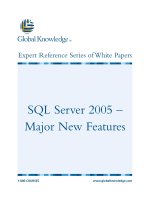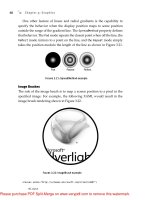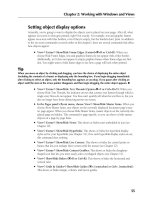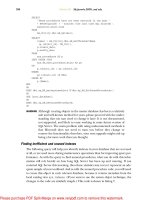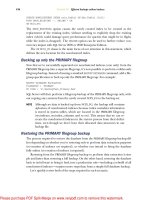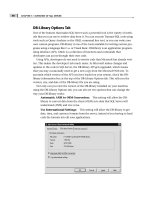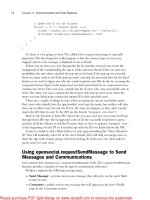Tài liệu SQL Clearly Explained- P3 ppt
Bạn đang xem bản rút gọn của tài liệu. Xem và tải ngay bản đầy đủ của tài liệu tại đây (425.77 KB, 50 trang )
98 Chapter 4: Simple SQL Retrieval
SELECT isbn
FROM volume
WHERE sale_id = 6
AND selling_price < asking_price;
Only two rows meet the criteria:
isbn
978-1-11111-130-1
978-1-11111-139-1
By the same token, if you wanted to see all sales that took place
prior to August 1, 2013 and for which the total amount of the
sale was less than $100, the query would be written
SELECT sale_id, sale_total_amt
FROM sale
WHERE sale_date < ‘1-Aug-2012’
AND sale_total_amt < 100;
It produces the result in Figure 4-10.
Note: Don’t forget that the date format required by your DBMS
may be dierent from the one used in examples in this book.
Alternatively, if you needed information about all sales that
occurred prior to or on August 1, 2013 that totaled more than
100 along with sales that occurred after August 1, 2013 that
totaled less than 100, you would write the query
isbn
978-1-11111-146-1
978-1-11111-122-1
978-1-11111-130-1
978-1-11111-126-1
978-1-11111-139-1
Figure 4-9: Displaying a single column from multiple rows using a
Please purchase PDF Split-Merge on www.verypdf.com to remove this watermark.
Choosing Rows 99
SELECT sale_id, sale_date, sale_total_amt
FROM sale
WHERE (sale_date <= ‘1-Aug-2013’
AND sale_total_amt > 100)
OR (sale_date > ‘1-Aug-2013’
AND sale_total_amt < 100);
Notice that although the AND operator has precedence over
OR and therefore the parentheses are not strictly necessary, the
predicate in this query includes parentheses for clarity. Extra
parentheses are never a problem—as long as you balance ev-
ery opening parenthesis with a closing parenthesis—and you
should feel free to use them whenever they help make it easier
to understand the meaning of a complex predicate. e result
of this query can be seen in Figure 4-11.
As an example of using one of the special predicate operators,
consider a query where someone wants to see all sales that oc-
curred between July 1, 2013 and August 31, 2013. e query
would be written
SELECT sale_id, sale_date, sale_total_amt
FROM sale
WHERE sale_date BETWEEN ‘1-Jul-2013’ AND ’31-
Aug-2013’;
It produces the output in Figure 4-12.
sale_id | sale_total_amt
+
3 | 58.00
7 | 80.00
8 | 90.00
9 | 50.00
13 | 25.95
14 | 80.00
15 | 75.00
Figure 4-10: Retrieving rows using a complex predicate including a
date
Using BETWEEN and NOT
BETWEEN
Please purchase PDF Split-Merge on www.verypdf.com to remove this watermark.
100 Chapter 4: Simple SQL Retrieval
e inverse query retrieves all orders not placed between July
1, 2013 and August 31, 2013 is written
SELECT sale_id, sale_date, sale_total_amt
FROM sale
WHERE sale_date NOT BETWEEN ‘1-Jul-2013’ AND
’31-Aug-2013’;
and produces the output in Figure 4-13.
sale_id | sale_date | sale_total_amt
+ +
4 | 30-JUN-13 00:00:00 | 110.00
5 | 30-JUN-13 00:00:00 | 110.00
6 | 05-JUL-13 00:00:00 | 505.00
10 | 10-JUL-13 00:00:00 | 125.00
11 | 10-JUL-13 00:00:00 | 200.00
12 | 10-JUL-13 00:00:00 | 200.00
16 | 25-JUL-13 00:00:00 | 130.00
2 | 05-JUN-13 00:00:00 | 125.00
1 | 29-MAY-13 00:00:00 | 510.00
19 | 01-SEP-13 00:00:00 | 95.00
20 | 01-SEP-13 00:00:00 | 75.00
Figure 4-11: Using a complex predicate that includes multiple logical
operators
sale_id | sale_date | sale_total_amt
+ +
6 | 05-JUL-13 00:00:00 | 505.00
7 | 05-JUL-13 00:00:00 | 80.00
8 | 07-JUL-13 00:00:00 | 90.00
9 | 07-JUL-13 00:00:00 | 50.00
10 | 10-JUL-13 00:00:00 | 125.00
11 | 10-JUL-13 00:00:00 | 200.00
12 | 10-JUL-13 00:00:00 | 200.00
13 | 10-JUL-13 00:00:00 | 25.95
14 | 10-JUL-13 00:00:00 | 80.00
15 | 12-JUL-13 00:00:00 | 75.00
16 | 25-JUL-13 00:00:00 | 130.00
17 | 25-JUL-13 00:00:00 | 100.00
18 | 22-AUG-13 00:00:00 | 100.00
Figure 4-12: Using BETWEEN to retrieve rows in a date range
Please purchase PDF Split-Merge on www.verypdf.com to remove this watermark.
Nulls and Retrieval: Three-Valued Logic 101
If we want output that is easier to read, we might ask the
DBMS to sort the result by sale date:
SELECT sale_id, sale_date, sale_total_amt
FROM sale
WHERE sale_date NOT BETWEEN ‘1-Jul-2013’
AND ’31-Aug-2013’
ORDER BY sale_date;
producing the result in Figure 4-14.
e predicates you have seen to this point omit one important
thing: the presence of nulls. What should a DBMS do when it
encounters a row that contains null rather than a known value?
As you read in Chapter 2, the relational data model doesn’t
have a specic rule as to what a DBMS should do, but it does
require that the DBMS act consistently when it encounters
nulls.
sale_id | sale_date | sale_total_amt
+ +
3 | 15-JUN-13 00:00:00 | 58.00
4 | 30-JUN-13 00:00:00 | 110.00
5 | 30-JUN-13 00:00:00 | 110.00
2 | 05-JUN-13 00:00:00 | 125.00
1 | 29-MAY-13 00:00:00 | 510.00
19 | 01-SEP-13 00:00:00 | 95.00
20 | 01-SEP-13 00:00:00 | 75.00
Figure 4-13: Using NOT BETWEEN to retrieve rows outside a date
range
sale_id | sale_date | sale_total_amt
+ +
1 | 29-MAY-13 00:00:00 | 510.00
2 | 05-JUN-13 00:00:00 | 125.00
3 | 15-JUN-13 00:00:00 | 58.00
5 | 30-JUN-13 00:00:00 | 110.00
4 | 30-JUN-13 00:00:00 | 110.00
19 | 01-SEP-13 00:00:00 | 95.00
20 | 01-SEP-13 00:00:00 | 75.00
Figure 4-14: Output sorted by date
Nulls and
Retrieval: Three-
Valued Logic
Please purchase PDF Split-Merge on www.verypdf.com to remove this watermark.
102 Chapter 4: Simple SQL Retrieval
Consider the following query as an example:
SELECT inventory_id, selling_price
FROM volume
WHERE selling_price < 100;
e result can be found in Figure 4-15. Notice that every row
in the result table has a value of selling price, which means that
rows for unsold items—those with null in the selling price col-
umn—are omitted. e DBMS can’t ascertain what the selling
price for unsold items will be: Maybe it will be less than $100
or maybe it will be greater than or equal to $100.
e policy of most DBMSs is to exclude rows with nulls from
the result. For rows with null in the selling price column, the
maybe answer to “Is selling price less than 100” becomes false.
is seems pretty straightforward, but what happens when you
have a complex logical expression of which one portion returns
maybe? e operation of AND, OR, and NOT must be ex-
panded to take into account that they may be operating on a
maybe.
e three-valued logic table for AND can be found in Table
4-5. Notice that something important hasn’t changed: e
only way to get a true result is for both simple expressions
linked by AND to be true. Given that most DBMSs exclude
rows where the predicate evaluates to maybe, the presence of
nulls in the data will not change what an end user sees.
e same is true when you look at the three-valued truth table
for OR (see Table 4-6). As long as one simple expression is
true, it does not matter whether the second returns true, false,
or maybe. e result will always be true.
If you negate an expression that returns maybe, the NOT op-
erator has no eect. In other words, NOT (MAYBE) is still
maybe.
Please purchase PDF Split-Merge on www.verypdf.com to remove this watermark.
Nulls and Retrieval: Three-Valued Logic 103
inventory_id | selling_price
+
2 | 50.00
4 | 25.95
5 | 22.95
6 | 76.10
11 | 25.00
12 | 15.00
13 | 18.00
18 | 30.00
19 | 75.00
23 | 45.00
24 | 35.00
25 | 75.00
26 | 55.00
33 | 50.00
35 | 75.00
36 | 50.00
37 | 75.00
39 | 75.00
40 | 25.95
41 | 40.00
42 | 40.00
50 | 50.00
51 | 50.00
52 | 50.00
53 | 40.00
54 | 40.00
55 | 60.00
56 | 40.00
57 | 40.00
59 | 35.00
58 | 25.00
60 | 45.00
61 | 50.00
62 | 75.00
Figure 4-15: Retrieval based on a column that includes rows with nulls
To see the rows that return maybe, you need to add an ex-
pression to your query that uses the IS NULL operator. For
example, the easiest way to see which volumes have not been
sold is to write a query like:
Please purchase PDF Split-Merge on www.verypdf.com to remove this watermark.
104 Chapter 4: Simple SQL Retrieval
SELECT inventory_id, isbn, selling_price
FROM volume
WHERE selling_price is null;
e result can be found in Figure 4-16. Note that the selling
price column is empty in each row. (Remember that you typi-
cally can’t see any special value for null.) Notice also that the
rows in this result table are all those excluded from the query
in Figure 4-15.
Table 4-5: Three-valued AND truth table
AND True False Maybe
True True False Maybe
False False False False
Maybe Maybe False Maybe
Table 4-6: Three-valued OR truth table
OR True False Maybe
True True True True
False True False Maybe
Maybe True Maybe Maybe
Four-Valued Logic
Codd’s 330 rules for the relational data model include an en-
hancement to three-valued logic that he called four-valued
logic. In four-valued logic, there are actually two types of null:
“null and it doesn’t matter that it’s null” and “null and we’ve
really got a problem because it’s null.” For example, if a com-
pany sells internationally, then it probably has a column for
Please purchase PDF Split-Merge on www.verypdf.com to remove this watermark.
Four-Valued Logic 105
inventory_id | isbn | selling_price
+ +
7 | 978-1-11111-137-1 |
8 | 978-1-11111-137-1 |
9 | 978-1-11111-136-1 |
10 | 978-1-11111-136-1 |
16 | 978-1-11111-121-1 |
17 | 978-1-11111-124-1 |
27 | 978-1-11111-141-1 |
28 | 978-1-11111-141-1 |
29 | 978-1-11111-141-1 |
30 | 978-1-11111-145-1 |
31 | 978-1-11111-145-1 |
32 | 978-1-11111-145-1 |
43 | 978-1-11111-132-1 |
44 | 978-1-11111-138-1 |
45 | 978-1-11111-138-1 |
46 | 978-1-11111-131-1 |
47 | 978-1-11111-140-1 |
48 | 978-1-11111-123-1 |
49 | 978-1-11111-127-1 |
63 | 978-1-11111-130-1 |
64 | 978-1-11111-136-1 |
65 | 978-1-11111-136-1 |
66 | 978-1-11111-137-1 |
67 | 978-1-11111-137-1 |
68 | 978-1-11111-138-1 |
69 | 978-1-11111-138-1 |
70 | 978-1-11111-139-1 |
71 | 978-1-11111-139-1 |
Figure 4-16: Using IS NULL to retrieve rows containing nulls
the country of each customer. Because it is essential to know
a customer’s country, a null in the country column would fall
into the category of “null and we’ve really got a problem.” In
contrast, a missing value in a company name column would be
quite acceptable in a customer table for rows that represent-
ed individual customers. en the null would be “null and it
doesn’t matter that it’s null.” Four-valued logic remains purely
theoretical, however, and isn’t implemented in DBMSs.
Please purchase PDF Split-Merge on www.verypdf.com to remove this watermark.
5
107
As you read in Chapter 1, logical relationships between entities
in a relational database are represented by matching primary
and foreign key values. Given that there are no permanent
connections between tables stored in the database, a DBMS
must provide some way for users to match primary and foreign
key values when needed using the join operation.
In this chapter you will be introduced to the syntax for in-
cluding a join in a SQL query. roughout this chapter you
will also read about the impact joins have on database per-
formance. At the end you will see how subqueries (SELECTs
within SELECTs) can be used to avoid joins and, in some
cases, signicantly decrease the time it takes for a DBMS to
complete a query.
ere are two types of syntax you can use for requesting the
join of two tables. e rst, which we have been calling the
“traditional” join syntax, is the only way to write a join in the
SQL standards through SQL-89. SQL-92 added a join syntax
that is both more exible and easier to use.
e traditional SQL join syntax is based on the combination
of the product and restrict operations that you read about in
Chapter 2. It has the following general form:
SELECT columns
FROM table1, table2
WHERE table1.primary_key = table2.foreign_key
Retrieving Data
from More Than
One Table
SQL Syntax for
Inner Joins
Traditional SQL
Joins
©2010 Elsevier Inc. All rights reserved.
10.1016/B978-0-12-375697-8.50005-4
Please purchase PDF Split-Merge on www.verypdf.com to remove this watermark.
108 Chapter 5: Retrieving Data from More Than One Table
Listing the tables to be joined after FROM requests the product.
e join condition in the WHERE clause’s predicate requests the
restrict that identies the rows that are part of the joined tables.
Don’t forget that if you leave o the join condition in the predi-
cate, then the presence of the two tables after FROM simply gen-
erates a product table.
Note: If you really, really, really want a product, use the CROSS
JOIN operator in the FROM clause.
For example, assume that someone wanted to see all the orders
placed by a customer whose phone number is 518-555-1111. e
phone number is part of the customer table; the purchase informa-
tion is in the sale table. e two relations are related by the pres-
ence of the customer number in both (primary key of the custom-
er table; foreign key in sale). e query to satisfy the information
request therefore requires an equi-join of the two tables over the
customer number, the result of which can be seen in Figure 5-1:
SELECT first_name, last_name, sale_id, sale_date
FROM customer, sale
WHERE customer.customer_numb = sale.customer_numb
AND contact_phone = ‘518-555-1111’;
ere are two important things to notice about the preceding
query:
◊ e join is between a primary key in one table and a for-
eign key in another. As you will remember from Chapter
first_name | last_name | sale_id | sale_date
+ + +
Janice | Jones | 3 | 15-JUN-13 00:00:00
Janice | Jones | 17 | 25-JUL-13 00:00:00
Janice | Jones | 2 | 05-JUN-13 00:00:00
Janice | Jones | 1 | 29-MAY-13 00:00:00
Figure 5-1: Output from a query containing an equi-join between a primary
key and a foreign key
Please purchase PDF Split-Merge on www.verypdf.com to remove this watermark.
SQL Syntax for Inner Joins 109
2, equi-joins that don’t meet this pattern are frequently
invalid.
◊ Because the customer_numb column appears in more
than one table in the query, it must be qualied by the
name of the table from which it should be taken. To
add a qualier, precede the name of a column by its
name, separating the two with a period.
Note: With some large DBMSs, you must also qualify the names of
tables you did not create with the user ID of the account that did
create the table. For example, if user ID DBA created the customer
table, then the full name of the customer number column would
be DBA.customer.customer_numb. Check your product documen-
tation to determine whether your DBMS is one of those that re-
quire the user ID qualier.
How might a SQL query optimizer choose to process this
query? Although we cannot be certain because there is more
than one order of operations that will work, it is likely that
the restrict operation to choose the customer with a telephone
number of 518-555-1111 will be performed rst. is cuts
down on the amount of data that needs to be manipulated for
the join. e second step probably will be the join operation,
because doing the project to select columns for display will
eliminate the column needed for the join.
e SQL-92 standard introduced an alternative join syntax
that is both simpler and more exible than the traditional
join syntax. If you are performing a natural equi-join, there
are three variations of the syntax you can use, depending on
whether the column or columns over which you are joining
have the same name and whether you want to use all matching
columns in the join.
Note: Despite the length of time that has passed since the introduc-
tion of this revised join syntax, not all DBMSs support all three
varieties of the syntax. You will need to consult the documentation
SQL-92 Join
Syntax
Please purchase PDF Split-Merge on www.verypdf.com to remove this watermark.
110 Chapter 5: Retrieving Data from More Than One Table
of your particular product to determine exactly which syntax you
can use.
When the primary key and foreign key columns you are join-
ing have the same name and you want to use all matching col-
umns in the join condition, all you need to do is indicate that
you want to join the tables, using the following general syntax:
SELECT column(s)
FROM table1 NATURAL JOIN table2
e query we used as an example in the preceding section
could therefore be written as
SELECT first_name, last_name, sale_id,
sale_date
FROM customer NATURAL JOIN sale
WHERE contact_phone = ‘518-555-1111’;
Note: Because the default is a natural equi-join, you will obtain
the same result if you simply use JOIN instead of NATURAL
JOIN.
e SQL command processor identies all columns in the two
tables that have the same name and automatically performs the
join of those columns.
Note: If you are determined to obtain a product rather than a nat-
ural join, you can do it using the SQL-92 CROSS JOIN operator.
If you don’t want to use all matching columns in a join condi-
tion but the columns still have the same name, you specify the
names of the columns over which the join is to be made by
adding a USING clause:
SELECT column(s)
FROM table1 JOIN table2 USING (column)
Using this syntax, the sample query would be written
SELECT first_name, last_name, sale_id,
Joins over All Columns with
the Same Name
Joins over Selected
Columns
Please purchase PDF Split-Merge on www.verypdf.com to remove this watermark.
SQL Syntax for Inner Joins 111
sale_date
FROM customer JOIN sale USING (customer_numb)
WHERE contact_phone = ‘518-555-1111’;
When the columns over which you are joining table don’t have
the same name, then you must use a join condition similar to
that used in the traditional SQL join syntax:
SELECT column(s)
FROM table1 JOIN table2 ON join_condition
In this case, the sample query will appear as
SELECT first_name, last_name, sale_id,
sale_date
FROM customer JOIN sale
ON customer.customer_numb = sale.customer_numb
WHERE contact_phone = ‘518-555-1111’;
All of the joins you have seen to this point have been performed
using a single matching column. However, on occasion you
may run into tables where you are dealing with concatenated
primary and foreign keys. As an example, we’ll return to the
four tables from the small accounting rm database that we
used in Chapter 2 when we discussed how joins over concat-
enated keys work:
accountant (acct_rst_name, acct_last_name,
date_hired, office_ext)
customer (customer numb, first_name, last_name,
street, city, state_province, zip_post-
code, contact_phone)
project (tax_year, customer_numb,
acct_first_name, acct_last_name)
form (tax_year, customer_numb, form_id,
is_complete)
To see which accountant worked on which forms during which
year, a query needs to join the project and form tables, which
Joins over Columns with
Dierent Names
Joining using
Concatenated Keys
Please purchase PDF Split-Merge on www.verypdf.com to remove this watermark.
112 Chapter 5: Retrieving Data from More Than One Table
are related by a concatenated primary key. e join condition
needed is
project.tax_year || project.customer_numb =
form.tax_year || form.customer_numb
e || operator represents concatenation in most SQL imple-
mentations. It instructs the SQL command processor to view
the two columns as if they were one and to base its comparison
on the concatenation rather than individual column values.
e following join condition produces the same result because
it pulls rows from a product table where both the customer ID
numbers and the tax years are the same:
project.tax_year = form.tax_year AND project.
customer_numb = form.customer_numb
You can therefore write a query using the traditional SQL join
syntax in two ways:
SELECT acct_first_name, acct_last_name,
form.tax_year, form.form_ID
FROM project, form
WHERE project.tax_year
|| project.customer_numb = form.tax_year
|| form.customer_numb;
or
SELECT acct_first_name, acct_last_name,
form.tax_year, form.form_ID
FROM project, form
project.tax_year = form.tax_year
AND project.customer_numb =
form.customer_numb;
If the columns have the same names in both tables and are the
only matching columns, then the SQL-92 syntax
SELECT acct_first_name, acct_last_name,
form.tax_year, form.form_ID
FROM project JOIN form;
Please purchase PDF Split-Merge on www.verypdf.com to remove this watermark.
SQL Syntax for Inner Joins 113
has the same eect as the preceding two queries.
When the columns have the same names but aren’t the only
matching columns, then you must specify the columns in a
USING clause:
SELECT acct_first_name, acct_last_name,
form.tax_year, form.form_ID
FROM project JOIN form USING (tax_year,
form_ID);
Alternatively, if the columns don’t have the same name, you
can use the complete join condition, just as you would if you
were using the traditional join syntax:
SELECT acct_first_name, acct_last_name,
form.tax_year, form.form_ID
FROM project JOIN form ON project.tax_year
|| project.customer_numb = form.tax_year
|| form.customer_numb;
or
SELECT acct_first_name, acct_last_name,
form.tax_year, form.form_ID
FROM project JOIN form
ON project.tax_year = form.tax_year
AND project.customer_numb =
form.customer_numb;
Notice that in all forms of the query, the tax year and form ID
columns in the SELECT clause are qualied by a table name.
It really doesn’t matter form which the data are taken, but be-
cause the columns appear in both tables, the SQL command
processor needs to be told which pair of columns to use.
What if you need to join more than two tables in the same
query? For example, some at the rare book store might want to
see the names of the people who have purchased a volume with
the ISBN of 978-1-11111-146-1. e query that retrieves that
information must join volume to sale to nd the sales on which
Please purchase PDF Split-Merge on www.verypdf.com to remove this watermark.
114 Chapter 5: Retrieving Data from More Than One Table
the volume was sold. en the result of the rst join must be
joined again to customer to gain access to the names.
Using the traditional join syntax, the query is written
SELECT first_name, last_name
FROM customer, sale, volume
WHERE volume.sale_id = sale.sale_id
AND sale.customer_numb =
customer.customer_numb
AND isbn = ‘978-1-11111-136-1’;
With the simplest form of the SQL-92 syntax, the query
becomes
SELECT first_name, last_name
FROM customer JOIN sale JOIN volume
WHERE isbn = ‘978-1-11111-136-1’;
Both syntaxes produce the following result:
first_name | last_name
+
Mary | Collins
Janice | Smith
Keep in mind that the join operation can work on only two
tables at a time. If you need to join more than two tables, you
must join them in pairs. erefore, a join of three tables re-
quires two joins, a join of four tables requires three joins, and
so on.
Although the SQL-92 syntax is certainly simpler than the tra-
ditional join syntax, it has another major benet: It gives you
control over the order in which the joins are performed. With
the traditional join syntax, the query optimizer is in complete
control of the order of the joins. However, in SQL-92, the
joins are performed from left to right, following the order in
which the joins are placed in the FROM clause.
Joining More than
Two Tables
Please purchase PDF Split-Merge on www.verypdf.com to remove this watermark.
SQL Syntax for Inner Joins 115
is means that you sometimes can aect the performance of a
query by varying the order in which the joins are performed.
1
Remember that the less data the DBMS has to manipulate, the
faster a query will execute. erefore, you want to perform the
most discriminatory joins rst.
As an example, consider the sample query used in the previous
section. e volume table has the most rows, followed by sale
and then customer. However, the query also contains a highly
discriminatory restrict predicate that limits the rows from that
table. erefore, it is highly likely that the DBMS will perform
the restrict on volume rst. is means that the query is likely
to execute faster is you write it so that sale is joined with volume
rst, given that this join will signicantly limit the rows from
sale that need to be joined with customer.
In contrast, what would happen if there was no restrict predi-
cate in the query, and you wanted to retrieve the name of the
customer for ever book ordered in the database? e query
would appear as
SELECT first_name, last_name
FROM customer JOIN sale JOIN volume;
First, keep in mind that this type of query, which is asking for
large amounts of data, will rarely execute as quickly as one that
contains predicates to limit the number of rows. Nonetheless,
if will execute a bit fast if customers is joined to sale before join-
ing to volume. Why? Because the joins manipulate fewer rows
in that order.
Assume that there are 20 customers, 100 sales, and 300 vol-
umes sold. Every sold item in volume must have a matching
1 is holds true only if a DBMS has implemented the newer join
syntax according to the SQL standard. A DBMS may support the syntax
without its query optimizer using the order of tables in the FROM clause
to determine join order.
SQL-92 Syntax and
Multiple-Table Join
Performance
Please purchase PDF Split-Merge on www.verypdf.com to remove this watermark.
116 Chapter 5: Retrieving Data from More Than One Table
row in sale. erefore, the result from that join will be at least
300 rows long. ose 300 rows must be joined to the 20 rows
in customer. However, if we reverse the order, then the 20 rows
in customer are joined to 100 rows in sale, producing a table of
100 rows, which can then be joined to volume. In either case,
we are stuck with a join of 100 rows to 300 rows, but when the
customer table is handled rst, the other join is 20 to 100 rows,
rather than 20 to 300 rows.
One of the limitations of a restrict operation is that its predi-
cate is applied to only one row in a table at a time. is means
that a predicate such as
isbn = ‘0-131-4966-9’ AND isbn = ‘0-191-4923-8’
and the query
SELECT first_name, last_name
FROM customer JOIN sale JOIN volume
WHERE isbn = ‘978-1-11111-146-1’
AND isbn = ‘978-1-11111-122-1’;
will always return 0 rows. No row can have more than one
value in the isbn column!
What the preceding query is actually trying to do is locate cus-
tomers who have purchased two specic books. is means
that there must be at least two rows for a customer’s purchases
in volume, one for each for each of the books in question.
Given that you cannot do this type of query with a simple
restrict predicate, how can you retrieve the data? e tech-
nique is to join the volume table to itself over the sale ID. e
result table will have two columns for the book’s ISBN, one
for each copy of the original table. ose rows that have both
the ISBNs that we want will nally be joined to the sale table
(over the sale ID) and customer (over customer number)tables
so that the query an project the customer’s name.
Finding Multiple
Rows in One
Table: Joining a
Table to Itself
Please purchase PDF Split-Merge on www.verypdf.com to remove this watermark.
Finding Multiple Rows in One Table: Joining a Table to Itself 117
Before looking at the SQL syntax, however, let’s examine the
relational algebra of the joins so you can see exactly what is
happening. Assume that we are working with the subset of the
volume table in Figure 5-2. (e sale ID and the ISBN are the
only columns that aect the relational algebra; the rest have
been left o for simplicity.) Notice rst that the result of our
sample query should display the rst and last names of the
customer who made purchase number 6. (It is the only order
that contains both of the books in question.
e rst step in the query is to join the table in Figure 5-7 to
itself over the sale ID, producing the result table in Figure 5-3.
e columns that come from the rst copy have been labeled
T1; those that come from the second copy are labeled T2.
e two rows in black are those that have the ISBNs for which
we are searching. erefore, we need to follow the join with a
restrict that says something like
WHERE isbn (from table 1) = ‘978-1-11111-146-1’
AND isbn (from table 2) =
‘978-1-11111-122-1’
e result will be a table with one row in it (the second of the
two black rows in Figure 5-3.)
At this point, the query can join the table to sale over the sale
ID to provide access to the customer number of the person
who made the purchase. e result of that second join can
then be joined to customer to obtain the customer’s name
(Franklin Hayes). Finally, the query projects the columns the
user wants to see.
e challenge facing a query that needs to work with multiple
copies of a single table is to tell the SQL command processor
to make the copies of the table. We do this by placing the name
of the table more than once on the FROM line, associating
Correlation Names
Please purchase PDF Split-Merge on www.verypdf.com to remove this watermark.
118 Chapter 5: Retrieving Data from More Than One Table
sale_id (T1)| isbn | sale_id (T2)| isbn
+ + +
1 | 978-1-11111-111-1 | 1 | 978-1-11111-133-1
1 | 978-1-11111-111-1 | 1 | 978-1-11111-131-1
1 | 978-1-11111-111-1 | 1 | 978-1-11111-111-1
1 | 978-1-11111-131-1 | 1 | 978-1-11111-133-1
1 | 978-1-11111-131-1 | 1 | 978-1-11111-131-1
1 | 978-1-11111-131-1 | 1 | 978-1-11111-111-1
1 | 978-1-11111-133-1 | 1 | 978-1-11111-133-1
1 | 978-1-11111-133-1 | 1 | 978-1-11111-131-1
1 | 978-1-11111-133-1 | 1 | 978-1-11111-111-1
2 | 978-1-11111-142-1 | 2 | 978-1-11111-144-1
2 | 978-1-11111-142-1 | 2 | 978-1-11111-146-1
2 | 978-1-11111-142-1 | 2 | 978-1-11111-142-1
2 | 978-1-11111-146-1 | 2 | 978-1-11111-144-1
2 | 978-1-11111-146-1 | 2 | 978-1-11111-146-1
2 | 978-1-11111-146-1 | 2 | 978-1-11111-142-1
2 | 978-1-11111-144-1 | 2 | 978-1-11111-144-1
2 | 978-1-11111-144-1 | 2 | 978-1-11111-146-1
Figure 5-3: The result of joining the table in Figure 5-2 to itself (continued on next page)
sale_id | isbn
+
1 | 978-1-11111-111-1
1 | 978-1-11111-133-1
1 | 978-1-11111-131-1
2 | 978-1-11111-142-1
2 | 978-1-11111-144-1
2 | 978-1-11111-146-1
3 | 978-1-11111-133-1
3 | 978-1-11111-132-1
3 | 978-1-11111-143-1
4 | 978-1-11111-121-1
5 | 978-1-11111-121-1
6 | 978-1-11111-139-1
6 | 978-1-11111-146-1
6 | 978-1-11111-122-1
6 | 978-1-11111-130-1
6 | 978-1-11111-126-1
7 | 978-1-11111-125-1
7 | 978-1-11111-131-1
8 | 978-1-11111-126-1
8 | 978-1-11111-133-1
9 | 978-1-11111-139-1
10 | 978-1-11111-133-1
Figure 5-2: A subset of the volume table
Please purchase PDF Split-Merge on www.verypdf.com to remove this watermark.
Finding Multiple Rows in One Table: Joining a Table to Itself 119
2 | 978-1-11111-144-1 | 2 | 978-1-11111-142-1
3 | 978-1-11111-143-1 | 3 | 978-1-11111-133-1
3 | 978-1-11111-143-1 | 3 | 978-1-11111-132-1
3 | 978-1-11111-143-1 | 3 | 978-1-11111-143-1
3 | 978-1-11111-132-1 | 3 | 978-1-11111-133-1
3 | 978-1-11111-132-1 | 3 | 978-1-11111-132-1
3 | 978-1-11111-132-1 | 3 | 978-1-11111-143-1
3 | 978-1-11111-133-1 | 3 | 978-1-11111-133-1
3 | 978-1-11111-133-1 | 3 | 978-1-11111-132-1
3 | 978-1-11111-133-1 | 3 | 978-1-11111-143-1
5 | 978-1-11111-121-1 | 5 | 978-1-11111-121-1
4 | 978-1-11111-121-1 | 4 | 978-1-11111-121-1
6 | 978-1-11111-146-1 | 6 | 978-1-11111-139-1
6 | 978-1-11111-146-1 | 6 | 978-1-11111-126-1
6 | 978-1-11111-146-1 | 6 | 978-1-11111-130-1
6 | 978-1-11111-146-1 | 6 | 978-1-11111-122-1
6 | 978-1-11111-146-1 | 6 | 978-1-11111-146-1
6 | 978-1-11111-122-1 | 6 | 978-1-11111-139-1
6 | 978-1-11111-122-1 | 6 | 978-1-11111-126-1
6 | 978-1-11111-122-1 | 6 | 978-1-11111-130-1
6 | 978-1-11111-122-1 | 6 | 978-1-11111-122-1
6 | 978-1-11111-122-1 | 6 | 978-1-11111-146-1
6 | 978-1-11111-130-1 | 6 | 978-1-11111-139-1
6 | 978-1-11111-130-1 | 6 | 978-1-11111-126-1
6 | 978-1-11111-130-1 | 6 | 978-1-11111-130-1
6 | 978-1-11111-130-1 | 6 | 978-1-11111-122-1
6 | 978-1-11111-130-1 | 6 | 978-1-11111-146-1
6 | 978-1-11111-126-1 | 6 | 978-1-11111-139-1
6 | 978-1-11111-126-1 | 6 | 978-1-11111-126-1
6 | 978-1-11111-126-1 | 6 | 978-1-11111-130-1
6 | 978-1-11111-126-1 | 6 | 978-1-11111-122-1
6 | 978-1-11111-126-1 | 6 | 978-1-11111-146-1
6 | 978-1-11111-139-1 | 6 | 978-1-11111-139-1
6 | 978-1-11111-139-1 | 6 | 978-1-11111-126-1
6 | 978-1-11111-139-1 | 6 | 978-1-11111-130-1
6 | 978-1-11111-139-1 | 6 | 978-1-11111-122-1
6 | 978-1-11111-139-1 | 6 | 978-1-11111-146-1
7 | 978-1-11111-125-1 | 7 | 978-1-11111-131-1
7 | 978-1-11111-125-1 | 7 | 978-1-11111-125-1
7 | 978-1-11111-131-1 | 7 | 978-1-11111-131-1
7 | 978-1-11111-131-1 | 7 | 978-1-11111-125-1
8 | 978-1-11111-126-1 | 8 | 978-1-11111-133-1
8 | 978-1-11111-126-1 | 8 | 978-1-11111-126-1
8 | 978-1-11111-133-1 | 8 | 978-1-11111-133-1
8 | 978-1-11111-133-1 | 8 | 978-1-11111-126-1
9 | 978-1-11111-139-1 | 9 | 978-1-11111-139-1
10 | 978-1-11111-133-1 | 10 | 978-1-11111-133-1
Figure 5-3 (continued): The result of joining the table in Figure 5-2 to itself
Please purchase PDF Split-Merge on www.verypdf.com to remove this watermark.
120 Chapter 5: Retrieving Data from More Than One Table
each instance of the name with a dierent alias. Such aliases for
table names are known as correlation names and take the syntax
FROM table_name AS correlation_name
For example, to instruct SQL to use two copies of the volume
table you might use
FROM volume AS T1, volume AS T2
e AS is optional. erefore, the following syntax is also legal:
FROM volume T1, volume T2
In the other parts of the query, you refer to the two copies us-
ing the correlation names rather than the original table name.
Note: You can give any table a correlation name; its use is not re-
stricted to queries that work with multiple copies of a single table.
In fact, if a table name is dicult to type and appears several times
in a query, you can save yourself some typing and avoid problems
with typing errors by giving the table a short correlation name.
e query that performs the same-table join needs to specify
all of the relational algebra operations you read about in the
preceding section.
It can be written using the traditional join
syntax as follows
:
SELECT first_name, last_name
FROM volume T1, volume T2, sale, customer
WHERE T1.isbn = ‘978-1-11111-146-1’
AND T2.isbn = ‘978-1-11111-122-1’
AND T1.sale_id = T2.sale_id
AND T1.sale_id = sale.sale_id
AND sale.customer_numb =
customer.customer_numb;
ere is one very important thing to notice about this query.
Although our earlier discussion of the relational algebra indi-
cated that the same-table join would be performed rst, fol-
lowed by a restrict and the other two joins, there is no way
Performing the
Same-Table Join
Please purchase PDF Split-Merge on www.verypdf.com to remove this watermark.
Outer Joins 121
using the traditional syntax to indicate the joining of an inter-
mediate result table (in this case, the same-table join). ere-
fore, the query syntax must join sale to either T1 or T2. None-
theless, it is likely that the query optimizer will determine that
performing the same-table join, followed by the restrict, is a
more ecient way to process the query than joining sale to T1
rst.
If you use the SQL-92 join syntax, then you have some control
over the order in which the joins are performed:
SELECT first_name, last_name
FROM volume T1 JOIN volume T2
ON (T1.sale_id = T2.sale_id)
JOIN sale JOIN customer
WHERE T1.isbn = ‘978-1-11111-146-1’
AND T2.isbn = ‘978-1-11111-122-1’;
e SQL command processor will process the multiple joins
in the FROM clause from left to right, ensuring that the same-
table join is performed rst.
As you read in Chapter 2, an outer join is a join that includes
rows in a result table even though there may not be a match
between rows in the two tables being joined. Whenever the
DBMS can’t match rows, it places nulls in the columns for
which no data exist. e result may therefore not be a legal
relation, since it may not have a primary key. However, because
a query’s result table is a virtual table that is never stored in
the database, having no primary keys doesn’t present a data
integrity problem.
To perform an outer join using the SQL-92 syntax, you in-
dicate the type of join in the FROM clause. For example, to
perform a left outer join between the customer and sale tables
you could type
SELECT first_name, last_name, sale_id,
sale_date
FROM customer LEFT OUTER JOIN sale;
Outer Joins
Please purchase PDF Split-Merge on www.verypdf.com to remove this watermark.
122 Chapter 5: Retrieving Data from More Than One Table
e result appears in Figure 5-4. Notice that ve rows appear
to be empty in the sale_id and sale_date columns. ese ve
customers haven’t made any purchases. erefore, the columns
in question are actually null. However, most DBMSs have no
visible indicator for null; it looks as if the values are blank. It is
the responsibility of the person viewing the result table to real-
ize that the empty spaces represent nulls rather than blanks.
e SQL-92 outer join syntax for joins has the same options
as the inner join syntax:
◊ If you use the syntax in the preceding example, the
DBMS will automatically perform the outer join on all
matching columns between the two tables.
◊ If you want to specify the columns over which the
outer join will be performed and the columns have the
same names in both tables, add a USING clause:
Matching More than Two Rows
You can extend the same table join technique you have just
read about to nd as many rows in a table you need. Create
one copy of the table with a correlation name for the number
of rows the query needs to match in the FROM clause and join
those tables together. In the WHERE clause, use a predicate
that includes one restrict for each copy of the table. For exam-
ple, to retrieve data that have four specied rows in a table, you
need four copies of the table, three joins, and four expressions
in the restrict predicate. e general format of such a query is
SELECT column(s)
FROM table_name T1 JOIN table_name T2
JOIN table_name T3 JOIN table_name T4
WHERE T1.column_name = value
AND T2.column_name = value
AND T3.column_name = value
AND T4.column_name = value
Please purchase PDF Split-Merge on www.verypdf.com to remove this watermark.
Matching More than Two Rows 123
SELECT first_name, last_name, sale_id,
sale_date
FROM customer LEFT OUTER JOIN sale
USING (customer_numb);
◊ If the columns over which you want to perform the
outer join do not have the same name, then append an
ON clause that contains the join condition:
SELECT first_name, last_name
FROM customer T1
LEFT OUTER JOIN sale T2
ON (T1.customer_numb =
T2.customer_numb);
first_name | last_name | sale_id | sale_date
+ + +
Janice | Jones | 1 | 29-MAY-13
Janice | Jones | 2 | 05-JUN-13
Janice | Jones | 17 | 25-JUL-13
Janice | Jones | 3 | 15-JUN-13
Jon | Jones | 20 | 01-SEP-13
Jon | Jones | 16 | 25-JUL-13
Jon | Jones | 13 | 10-JUL-13
John | Doe | |
Jane | Doe | 4 | 30-JUN-13
Jane | Smith | 18 | 22-AUG-13
Jane | Smith | 8 | 07-JUL-13
Janice | Smith | 19 | 01-SEP-13
Janice | Smith | 14 | 10-JUL-13
Janice | Smith | 5 | 30-JUN-13
Helen | Brown | |
Helen | Jerry | 9 | 07-JUL-13
Helen | Jerry | 7 | 05-JUL-13
Mary | Collins | 11 | 10-JUL-13
Peter | Collins | 12 | 10-JUL-13
Edna | Hayes | 15 | 12-JUL-13
Edna | Hayes | 10 | 10-JUL-13
Franklin | Hayes | 6 | 05-JUL-13
Peter | Johnson | |
Peter | Johnson | |
John | Smith | |
Figure 5-4: The result of an outer join
Please purchase PDF Split-Merge on www.verypdf.com to remove this watermark.
